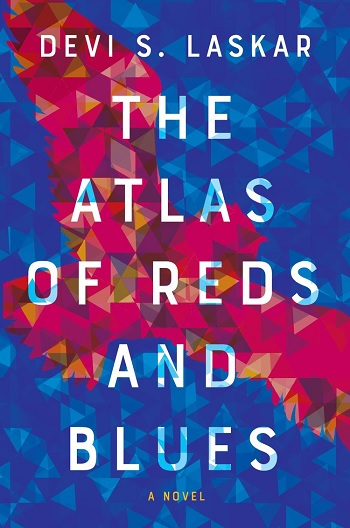On February 6, 2015, Sureshbhai Patel, visiting his son’s home in Madison, Alabama, was beaten by police officer Eric Parker. Parker was answering a call from “concerned” neighbor who felt impending danger at a 57-year-old Indian man taking a walk down the perfectly paved suburban street.

Almost four years to the day after, Devi S. Laskar released debut novel The Atlas of Reds and Blues (Counterpoint Press). The novel opens on Mother, who has been shot by the police, and lays bleeding in her suburban driveway while they trade barbs over her body like water cooler chat.
The premise comes from Laskar’s own experience with a police raid on her home, and though she was not shot, the incident becomes a prism through which she refracts her experiences as a second generation Brown woman. Mother dislodges from her self, becoming an apparition reliving moments from her past, like tiles comprising a mosaic: perhaps beautiful from afar, but crude, cracked, and decayed when examined up close?
Laskar’s novel is woven from short, imagistic chapters, sometimes no more than a sentence, following several strands, that never quite coalesce into a full plot. The main character is referred to as Mother in the present and The Real Thing in childhood flashbacks. She was born in North Carolina, lives in a posh Atlanta suburb with her three daughters and white husband, called alternatively The Hero and Man of the Hour. She’s a journalist, first crime then obituaries. She loves her dog, Greta, who may be the only family member she can be nakedly, lovingly truthful to.
“The premise comes from Laskar’s own experience with a police raid on her home.”
In between these strands, several chapters detail the secret history of the Barbie doll, and the abstractions made to justify the doll’s ridiculous beauty standards despite changing times.
Barbie becomes another prism for the world; For Mother, the suburbs are a peril; she is surrounded by perfect Barbie dolls, a world of perfect blonde white women in large houses with accessory cars. Mother too has the perfect partner, home, and the car — but her husband plays skeptical to her charges of racism, her home is besieged by intruders, and her car constantly gets pulled over by the police.
Most crushing is that Mother too has to keep up the veneer to stave off deep pains from day-to-day living; Middle Daughter suffers bullying in school, but it’s kept secret from The Hero. The Real Thing tries to find her place among the other white kids, and Mother tries to assert the roles she has — journalist, mother, reader, wife, woman — stifling one urge for the socially acceptable, holding back one secret for the happy truth.
In these suburbs, racism is oblique, manifested as wholesome values or a kindly looking-out. Laskar injects bone-chills into innocuous situations. In one a pregnant Mother is pelted with judgment by a grocery cashier about her junk food selections. He doesn’t believe they’re for her husband and calls out her ringless finger as proof. When Mother pushes back, the cashier smiles and claims it was just good looking-out. In another, Mother visits her dry cleaner, Mr. Patel, on September 12, 2001. A white customer comes in, takes his clothes with superficial geniality and rushes out, but not before looking at Mother and saying, “You need to get on home, girl.” She softly replies, “I am home.”
“You need to get on home, girl.” She softly replies, “I am home.”
Reading this, I had a sensation much like Mother, as if the book had shaken me out of my body and into memory: In those grey autumn days following 9/11, I went into a gas station with my father to pay the attendant. We were on our way home from the temple. No words were exchanged, no outward actions except changing money. But when we got back to the car he said maybe for a while we shouldn’t wear any Indian clothes, or place red powder on our foreheads.
The conversations then, in my family and the families we knew, were of confusion — it felt like we were also living in a fugue state, at once keenly aware of the political reality we were living in but unable to wrap our heads around it to adapt and react to it.
Similarly, with each short chapter (separated only by an “&”, as if this is an ever-growing, never-ending concept map) the novel feels as if it’s trying to disseminate our American moment, where attacks based on race, immigration, and womanhood, become so common they seem to wash over us like numbing waves.
Reading Laskar’s novel, we too feel as if we are wandering in a fugue, walking about in nebulous time and space, where the small microagressive “&s” are laid bare on a map, exploring if not how, but why this happened to Mother, lying in the driveway, on an affluent, sun-lit Georgia street with large yards and paved driveways. No, here racism isn’t voiced or shown outwardly. In the suburbs, these moments of quiet violence become paved over.
* * *
Aditya Desai lives in Baltimore, currently teaching writing and revising a couple novels that he keeps threatening to finish someday. He received his MFA in Fiction from the University of Maryland, College Park. His stories, essays, and poems have appeared in B O D Y, The Rumpus, The Millions, The Margins, District Lit, The Kartika Review, CultureStrike, and others, which you can find most of at adityadesaiwriter.com. Find him on Twitter @atwittya.












